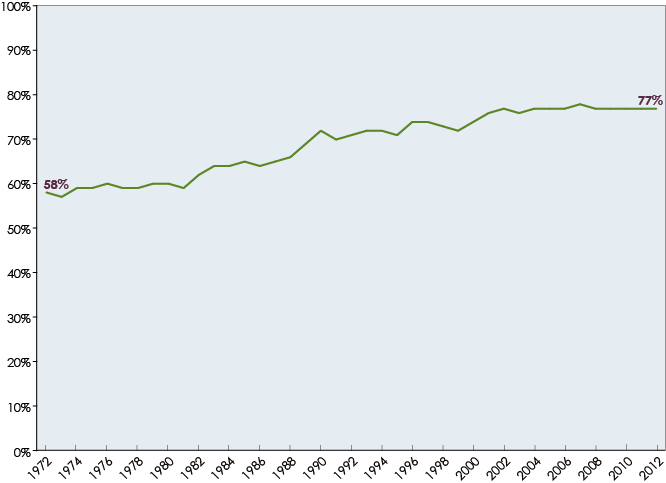
For years now we have been studying the pay gap between men and women. The disparity has not changed much over the last decade. On average women make 77 cents to every dollar a man earns.
A study released last week by The American Association of University Women (AAUW), confirmed what other similar studies have shown. We are not making significant progress in closing the gender pay gap.
The AAUW study examined the underlying reasons for the gaps that have been offered in the past.
- Men and women tend to choose different majors in college. Men tend to select occupations that pay more. There is an inherent bias issue here. Who decides what occupations are higher paying?
- Women tend to work fewer hours, even when they work full time.
- Women are more likely to leave the workforce or to work part time when they have young children.

Women’s Median Annual Earnings as a Percentage of Men’s Median Annual Earnings for Full-time, Year-Round Workers, 1972–2012 (Source: US Census Bureau, Current Population Survey)
These reasons account for only some of the differences in salaries. According to the study there is still a 7% gap in men’s and women’s salaries one year after college graduation that is not explained.
There are legislative measures that have been pending in Congress for several years to address discriminatory practices that contribute to the gender-based wage gap including,
The Paycheck Fairness Act (S. 84/H.R. 377): If passed it would expand the Equal Pay Act by requiring employers to prove that wage gaps between men and women doing the same work have a business justification and are a result of factors other than sex. It would also permit wage comparisons between employees to determine fair wages and prohibit employer retaliation against workers who inquire about wage practices or disclose their own wages.
The Fair Pay Act (S. 168/H.R. 438): This law would prohibit wage discrimination based on sex, race, and national origin by requiring employers to provide equal pay for work of equal value, whether or not the jobs are the same. This bill is particularly helpful for women working in female-dominated jobs equivalent in skills, effort, responsibility, and working conditions to jobs dominated by men. For example, a social worker (traditionally female) and a parole officer (traditionally male).
While the Walmart v. Dukes, a 2011 Supreme Court decision, severely restricted the ability of workers to fight discrimination together in a class action, backers in the House and Senate are working on fixing the decision legislatively.
At an organizational level, the inclusion solution is to examine salaries by gender and fix the discrepancies. Women also need to be vigilant, knowledgeable of salary ranges and how what they make compare to comparable male salaries.


















